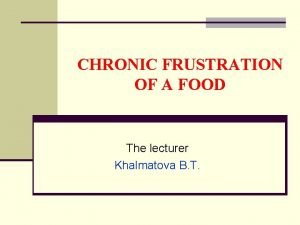Effects of Frustration on the Synchronization of Chemical

- Slides: 1

Effects of Frustration on the Synchronization of Chemical Oscillators Bulbul Chakraborty, Martin Fisher School of Physics, Brandeis University Recent experiments in one and two-dimensional microfluidic arrays of droplets containing Belousov Zhabotinsky reactants show a rich variety of spatial patterns [J. Phys. Chem. Lett. 1, 1241 -1246 (2010)]. The dominant coupling between these droplets is inhibitory. Motivated by this experimental system, we have studied repulsively coupled phase oscillators on a triangular lattice in two dimensions. On this lattice the local preference for oscillators to be 180º out of phase is not compatible with global order. As in the experiments, we find that there is a phase-ordered state in which oscillators on a triangle are 120º out of phase , and all triangles have either a clockwise or anticlockwise arrangement. As the coupling strength increases, however, the phases become disordered with domains of clockwise and anticlockwise arrangements and oscillators with 180º phase differences occurring at the domain boundaries. The oscillators in the interior of the domains are frequency synchronized in these disordered states. Two stable attractors: oscillators are 120º out of phase in clockwise/anticlockwise direction on a triangle Oscillators on a triangular lattice with random frequencies synchronize as they are coupled with increasing strength, K. Domains of oscillators with clockwise (white) and anticlockwise (green) phase patterns. A large number of oscillators are oscillating at the same frequency in the interior of the white domain

